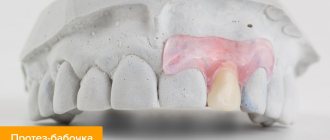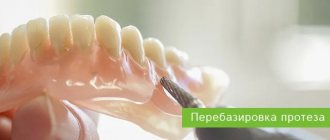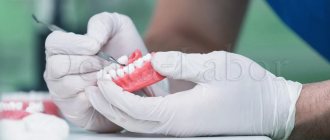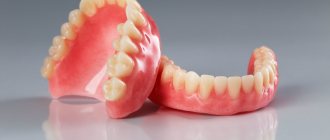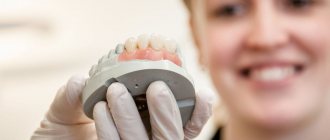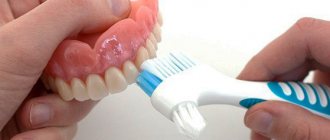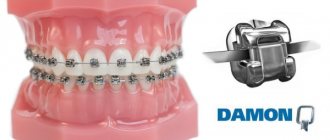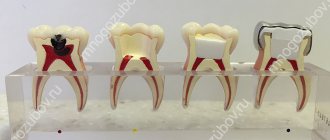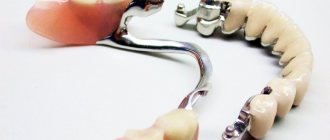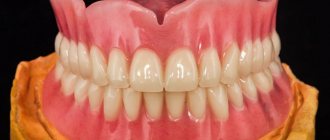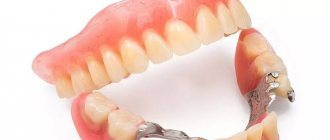Repairing a removable denture is a technical manipulation aimed at restoring its appearance, integrity and functionality. It is carried out in dental clinics or denture laboratories. According to statistics, breakage of prostheses is a common phenomenon, which is encountered by 10% of patients treated by an orthopedist. The reasons that led to this can be of various origins, and even the most expensive and high-quality products are not immune from problems. It is not always necessary to make a new prosthesis; it is quite likely that it can be repaired without incurring significant material costs.
Common causes of removable denture malfunctions
The most common causes of removable denture failures:
- A manufacturing defect.
- Failure to comply with or violation of prosthesis installation technology.
- Improper or careless care of the prosthesis.
- Increased chewing load on the structure.
- Injury due to impact with a hard surface.
- Poor quality material.
- Changes in the structure of supporting teeth (looseness, destruction).
- Use of a prosthesis after its service life has expired.
All this causes the need for restoration of a removable denture. It must be performed by qualified dental technicians.
The nuances of using plate dentures
- Relative fragility. There is a high risk of deformation under significant loads on the artificial system. If the plastic structure is used carefully and not loaded with solid food, it will last for the entire period of use.
- There are problems with getting used to it and discomfort when wearing it. This is due to pressure on the gums, as well as the large size of the base. At first, there may be problems with diction (especially with pronouncing hissing and whistling sounds). However, modern dental technologies do not stand still - the most comfortable systems are manufactured, which you get used to very quickly, and which do not injure your gums.
- There is no load on the bone. However, if you install a removable prosthetic structure supported by metal implants, the load will be distributed on the bone tissue.
Repairing removable dentures
Of course, you can find a lot of advice on how to repair removable dentures yourself, but there are negative aspects to this. You can completely damage the product, making it unsuitable for restoration. Or there are defects that cannot be detected visually, but are noticeable when worn. Therefore, it is wiser to turn to qualified specialists - this will save your money and time.
Clasp dentures
The clasp design is used when at least several supporting teeth are present. It is characterized by high strength due to the presence of a metal arc. But, nevertheless, the service life of the clasps is not very long; they may periodically require repairs. However, if the arch or frame is fractured, it is not possible to repair them; new ones must be ordered. The cost and duration of restoration of the prosthetic system depend on the complexity of the breakdown. On average, repairs take no more than 3 hours. What can happen to clasp removable dentures:
- appearance of cracks or fracture of the base plate.
The technician glues the damaged parts and brings it into proper condition. The work is carried out within a couple of hours; - The clasp
(a device for attaching the prosthesis to the supporting tooth) has broken. The defect can be simple or complex. It can be eliminated by welding or replacing bushings. Time costs – from 2 to 4 hours; - loss of crowns.
The cost of eliminating this problem is affected by the possibility of installing an existing element or whether a new crown needs to be fixed; - the base has darkened.
In this situation, the aesthetic factor suffers - the structure becomes clearly visible in the oral cavity, which patients may not like. The issue is resolved within one hour.
How are broken dentures fixed?
Some patients try to restore the integrity of broken bases or artificial teeth on their own. It only makes sense to do this if it is not possible to see an orthopedic dentist in the near future, and the damaged prosthesis is made of acrylic. Nylon and clasp structures, metal-ceramic crowns and bridges are subject to professional repair only.
The following defects can be eliminated:
- Chip of a small area in the ceramic layer of the crown. The damage site is masked with composite material.
- Loss of one of the crowns of the bridge system. The specialist places the artificial tooth in place.
- Fracture of prosthetic structure fastenings. Damaged locks or hooks can be quickly replaced.
- Linear fracture of the base of a removable denture. To restore the integrity of the structure, special technology is used.
Repairing nylon dentures
The restoration process of nylon artificial elements is quite labor-intensive. They should be handled by good technicians from a laboratory or prosthetic repair shop. Patients often present with the following problems:
- crown loss.
Product repair involves the use of special dental adhesives or resins. After gluing is completed, the treated area is polished; - damage to the fasteners.
Dental laboratory workers use adhesives that securely hold the components that hold the prosthesis on the teeth; - failure of the base.
Here it is not enough to simply connect parts of the structure; it needs to be strengthened. For this, a metal mesh is used; - weakening of the fixing properties of the prosthesis.
In order to restore fastening abilities, a special procedure is prescribed - relining the removable denture. This is quite a difficult and painstaking work; it takes from one day (in a clinical setting) or more time (in a laboratory transfer).
Any problem in the prosthetic structure requires an individual approach and high professionalism on the part of the dental technician.
How do bridge structures most often break?
If we talk about “bridges,” then this type of prosthetic device is considered not the most reliable and durable. Crowns secured to each other may also develop chips and cracks. In other cases, breakdowns of fastening elements (clasps, attachments or “wings” if it is an adhesive system) occur. Due to natural wear and tear, the distribution of chewing load is distorted, which soon leads to failure of the product, damage and destruction of supporting teeth, and even more rapid development of atrophic processes in bone tissue.
“I spent about 5 years with a bridge on my lateral upper teeth. As a result, it turned out that one of the supporting teeth was completely destroyed due to caries. There was no point in saving it, all the roots had already rotted. And I felt it only when my gums became inflamed. There was no nerve in this tooth, so I didn’t understand what was happening. Although it’s still my own fault, I had to go to the dentist every six months.”
Inna_85, from correspondence on the forum www.32top.ru
As practice shows, in most cases the bridge prosthesis has to be replaced before its stated service life, and the culprit is usually carious processes that imperceptibly destroy the supporting elements. Since the “bridge” is fixed on pulpless teeth, it can be problematic to recognize the onset of the pathological process in time. Teeth devoid of nerves do not give appropriate pain signals, but soon the disease leads to inflammation of the surrounding gums and the development of complications. Therefore, if you have a “bridge” in your mouth, be sure to visit the dentist for preventive care at least twice a year.
Measures to prevent breakdowns
Breakage of a denture is a big nuisance. To avoid it, you need to carefully care for the structure, handle it carefully and regularly visit an orthopedic doctor to monitor its condition. What to do at home:
- remove and thoroughly clean any stuck pieces of food;
- do not use toothpastes with a strong abrasive effect;
- buy a toothbrush with soft bristles;
- rinse after every meal, no matter whether it was a full meal or a tasting;
- remove dentures over a towel or cup of water - this reduces the risk of hitting a hard surface and, as a result, severe mechanical damage.
Even though the material used in removable denture systems is quite smooth, bacteria can also accumulate and multiply on it. To ensure optimal disinfection, special pharmaceutical products should be used. Your doctor will tell you which ones exactly.
Unfortunately, many people are now forced to resort to prosthetics. The development of dental technologies makes it possible to produce removable elements that are practically indistinguishable from natural teeth in appearance and quality. Our clinic’s specialists are highly qualified, they are always up to date with innovative developments and use only high-quality materials. Do not worry about the breakdown of the prosthetic structure - with us you can get prompt assistance from an orthopedic dentist at an affordable price.
What to do if the prosthesis breaks?
If your denture breaks:
- You should not throw it away, even if it seems that the defect cannot be repaired.
- You need to carefully collect and place in a dry container all the broken elements.
- Then you should contact the dentist who performed the prosthetics and make an appointment, stating the purpose of the visit.
As a rule, a patient with a broken prosthesis is scheduled to see an orthopedist in the near future. Already in the clinic, the dentist examines the structure and informs whether repair is possible.
Which doctor should I contact?
To assess the condition of the structure and help in repairing it, you need to contact the orthopedist who installed it for you. The best option is if the clinic you choose has a dental laboratory where they repair dentures, and not just create them. This will speed up the process without wasting time searching for a specialized workshop, waiting for delivery of the finished product, etc.
Restoring the integrity, function and aesthetics of artificial teeth is a job for dental technicians. Simple damage can be repaired on the same day of treatment in a few hours, especially if the clinic is equipped with its own dental laboratory. Indeed, for many patients, artificial teeth are a vital necessity, but how long the elimination of defects will take depends on the type and number of defects.
Remember that if your prosthesis is still under warranty, then in this case you absolutely need to contact the clinic where it was created for you. Intervention by third party specialists will result in loss of warranty.
If a defect appears during the warranty period, the device can be repaired free of charge by seeking help from an orthopedist who supervised the production of the system in a dental laboratory and installed it. Of course, free repairs are possible if you can come up with arguments that you followed all the doctor’s recommendations for care and operation, and the breakdowns were not your fault.
Removable Device Recovery
Removable ones include acrylic systems, dentures with locks (attachments) without an artificial palate, clasp ones, where the base is metal arches, soft Quattro Ti, as well as thin and light Acry-Free.
The manufacture and repair of removable orthopedic appliances is one of the most popular types of dental care. Basically, their base is made of a monolith, the fracture of which can extremely rarely be repaired - only chips and broken hooks can be restored. When artificial crowns fall out, they are replaced by simply soldering them into place. When artificial enamel is chipped, it is restored using composite materials.
The situation is more complicated with clasp dentures if the metal arches that need to be soldered are damaged. Let’s look at how removable dentures are repaired and what stages the renovation may consist of using the example of reconstructing damage to a plate or acrylic denture:
- after cleaning, all parts are put together in the correct relationship to each other and fixed using adhesive wax and special holding devices,
- using a brush, an insulating substance is applied to the prosthetic bed (the back part that will face the plaster) to prevent sticking to the plaster model,
- To hold all the parts together, a backing is made from class I gypsum - a sub-cast that follows the shape of the patient's jaw. All parts connected in the first point are separated again, the broken edges are processed with cutters. The processed parts are placed on the lining, like a puzzle,
- the edges of the broken bevels are processed at an angle of 45 degrees to the base to ensure a smooth transition between the old and new plastics and their good adhesion to each other,
- a liquid insulating material is applied to the plaster so that moisture from the gypsum does not get into the new plastic,
- the parts to be glued are treated with monomer and fixed to the model,
- knead the plastic, strictly following the instructions for the ratio of components, and apply it to the joints of the disparate parts with a slight excess, after which it is polymerized in a special apparatus,
- Once the new resin has hardened, the excess material is removed and the surface of the denture is leveled, sanded and polished until smooth.
In case of other breakdowns, the steps may be different and complex devices and tools may be used. Cast metal arches - clasps - are difficult to repair. To do this, teeth and gums made of polymers are removed from the arch, and the broken metal parts are soldered together using a laser. Self-hardening adhesives are also used for acrylic devices. If there is no element in the form of an artificial tooth, then a plastic one can be built up, and a ceramic one can literally be “implanted” at high temperatures.
Nylon prostheses are glued together with special liquids, but the special technology of their manufacture often makes them unsuitable for repair. In addition, they are one of the most flexible to stretching and changing shape; even with a short period of use, they often require adjustment.
Features of repair depending on materials
The different materials from which the devices are made dictate their own characteristics of their restoration and the selection of special and compatible replenishing agents. Thus, repair of the base of acrylic dentures, which are fragile, is carried out with self-hardening resins.
Repair of nylon devices consists mainly of restoring crowns, which may have chips or cracks - the elastic base itself is rarely damaged. But it stretches after just a couple of years of wearing it - nothing can be done about it, you will have to completely change the prosthesis. Crown defects are eliminated using adhesives and resins. All types of breakdowns occur with short-lived plastic products.
Metal-ceramic structures are less susceptible to damage and are generally more reliable than others, but chipping of the ceramic coating is also possible here. It is restored, as a rule, with composite materials, applied in several layers over the chip.
Today, dentists use many different modern materials, glues, adhesives, both imported and domestic, which allow reconstruction to be carried out quite quickly. Dental technicians and orthopedists also have advanced equipment, computer programs and tools at their disposal.
Fracture of clasp (metal hook)
In the dental office, the doctor takes an impression of the patient’s mouth along with the prosthesis and sends it to the dental technician in the laboratory. A plaster model is cast along with the prosthesis. The technician removes the broken clasp from the inside of the denture and bends a new one along the supporting tooth. After polymerization of the plastic, it is applied first to the site of the sawn hook, then to the outside of the prosthesis. After a short period of time, excess plastic is removed with a cutter on an electric motor, and the repair area is processed and polished, if necessary.
Repair or complete replacement: which is cheaper and easier?
Not all patients who wear removable or fixed orthotic devices are sure whether denture repair is possible. And most, faced with such a situation, believe that this is an expensive pleasure. But devices, both with minor damage and with severe breakdowns, can be sent to a workshop if there is still a lot of time before the end of their service life and it is too early to write it off as scrap. This will be rational, especially since repairing a structure is often cheaper than ordering a new one. But, of course, there are also situations when it is easier to replace lost teeth with a new device due to the complexity of restoration, changed conditions of prosthetics (supporting teeth have fallen out, there is an allergy to the components of the materials) or when it is impossible to guarantee with certainty that it will not soon have to be repaired again due to the same reason.
OPERATIVE PROSTHETICS WITH ACRYLIC PROSTHETICS - from RUR 180,000.
Re-prosthetics with an acrylic bridge on a metal frame (all included) up to 12 units.
Save RUR 30,000. Call now or request a call
Linear fracture
In order to repair a denture, a dental technician glues its two parts together with super glue, mixes plaster and makes a plaster model of the denture. After crystallization of the plaster, the prosthesis is removed from the model, again opened into two parts, and a thick layer of plastic is removed from the prosthesis along the fracture line. Using an electric motor and a disc, herringbone cuts are made on the two parts of the prosthesis and they are placed back on the plaster model. Cold polymerization plastic is diluted, after it has matured, it is applied along the fracture line and leveled to the thickness of the prosthesis. The model is placed in cold water for 10-15 minutes to complete polymerization of the plastic. After time, the outer and inner surfaces of the prosthesis are ground using cutters and polished with rubber bands and felt.
